The Effect of Sensor Feature Inputs on Joint Angle Prediction across Simple Movements
Abstract
1. Introduction
2. Materials and Methods
3. Results
4. Discussion
5. Conclusions
Author Contributions
Funding
Institutional Review Board Statement
Informed Consent Statement
Data Availability Statement
Acknowledgments
Conflicts of Interest
References
- Demrozi, F.; Pravadelli, G.; Bihorac, A.; Rashidi, P. Human Activity Recognition Using Inertial, Physiological and Environmental Sensors: A Comprehensive Survey. IEEE Access 2020, 8, 210816–210836. [Google Scholar] [CrossRef] [PubMed]
- Coker, J.; Chen, H.; Schall, M.C.; Gallagher, S.; Zabala, M. EMG and Joint Angle-Based Machine Learning to Predict Future Joint Angles at the Knee. Sensors 2021, 21, 3622. [Google Scholar] [CrossRef] [PubMed]
- McGhan, C.; Nasir, A.; Atkins, E. Human Intent Prediction Using Markov Decision Processes. In Infotech@Aerospace 2012; American Institute of Aeronautics and Astronautics: Garden Grove, CA, USA, 2012. [Google Scholar] [CrossRef][Green Version]
- Cervantes, C.; De Mesa, M.; Ramos, J.; Singer, S.; Del Carmen, D.J.; Cajote, R.D. Multi-Stage Hybrid-CNN Transformer Model for Human Intent-Prediction. In Proceedings of the TENCON 2023—2023 IEEE Region 10 Conference (TENCON), Chiang Mai, Thailand, 31 October 2023; IEEE: Chiang Mai, Thailand; pp. 1151–1156. [Google Scholar] [CrossRef]
- Bi, L.; Feleke, A.G.; Guan, C. A review on EMG-based motor intention prediction of continuous human upper limb motion for human-robot collaboration. Biomed. Signal Process. Control 2019, 51, 113–127. [Google Scholar] [CrossRef]
- Tang, G.; Wang, H.; Tian, Y. sEMG-Based Estimation of Knee Joint Angles and Motion Intention Recognition. In Proceedings of the 2017 9th International Conference on Intelligent Human-Machine Systems and Cybernetics (IHMSC), Hangzhou, China, 26–27 August 2017; Volume 2, pp. 390–393. [Google Scholar] [CrossRef]
- Liu, Y.; Liu, X.; Wang, Z.; Yang, X.; Wang, X. Improving performance of human action intent recognition: Analysis of gait recognition machine learning algorithms and optimal combination with inertial measurement units. Comput. Biol. Med. 2023, 163, 107192. [Google Scholar] [CrossRef] [PubMed]
- Hu, B.; Rouse, E.; Hargrove, L. Fusion of Bilateral Lower-Limb Neuromechanical Signals Improves Prediction of Locomotor Activities. Front. Robot. AI 2018, 5, 78. [Google Scholar] [CrossRef] [PubMed]
- Anwary, A.R.; Yu, H.; Vassallo, M. Optimal Foot Location for Placing Wearable IMU Sensors and Automatic Feature Extraction for Gait Analysis. IEEE Sens. J. 2018, 18, 2555–2567. [Google Scholar] [CrossRef]
- Gurchiek, R.D.; Cheney, N.; McGinnis, R.S. Estimating Biomechanical Time-Series with Wearable Sensors: A Systematic Review of Machine Learning Techniques. Sensors 2019, 19, 5227. [Google Scholar] [CrossRef] [PubMed]
- Rana, M.; Mittal, V. Wearable Sensors for Real-Time Kinematics Analysis in Sports: A Review. IEEE Sens. J. 2021, 21, 1187–1207. [Google Scholar] [CrossRef]
- Weizman, Y.; Tirosh, O.; Fuss, F.K.; Tan, A.M.; Rutz, E. Recent State of Wearable IMU Sensors Use in People Living with Spasticity: A Systematic Review. Sensors 2022, 22, 1791. [Google Scholar] [CrossRef]
- Prathivadi, Y.; Wu, J.; Bennett, T.R.; Jafari, R. Robust activity recognition using wearable IMU sensors. In Proceedings of the 2014 IEEE SENSORS, Valencia, Spain, 2–5 November 2014; pp. 486–489. [Google Scholar] [CrossRef]
- Exoskeletons Need to React Faster than Physiological Responses to Improve Standing Balance. Available online: https://www.science.org/doi/10.1126/scirobotics.adf1080 (accessed on 10 July 2023).
- Novak, D.; Riener, R. A survey of sensor fusion methods in wearable robotics. Robot. Auton. Syst. 2015, 73, 155–170. [Google Scholar] [CrossRef]
- Farrell, M.T.; Herr, H. A method to determine the optimal features for control of a powered lower-limb prostheses. In Proceedings of the 2011 Annual International Conference of the IEEE Engineering in Medicine and Biology Society, Boston, MA, USA, 30 August–3 September 2011; pp. 6041–6046. [Google Scholar] [CrossRef]
- Kazemimoghadam, M.; Fey, N.P. Continuous Classification of Locomotion in Response to Task Complexity and Anticipatory State. Front. Bioeng. Biotechnol. 2021, 9. [Google Scholar] [CrossRef] [PubMed]
- Kazemimoghadam, M.; Fey, N.P. Biomechanical Signals of Varied Modality and Location Contribute Differently to Recognition of Transient Locomotion. Sensors 2020, 20, 5390. [Google Scholar] [CrossRef] [PubMed]
- Niswander, W.; Wang, W.; Kontson, K. Optimization of IMU Sensor Placement for the Measurement of Lower Limb Joint Kinematics. Sensors 2020, 20, 5993. [Google Scholar] [CrossRef] [PubMed]
- Dey, S.; Yoshida, T.; Foerster, R.H.; Ernst, M.; Schmalz, T.; Schilling, A.F. Continuous Prediction of Joint Angular Positions and Moments: A Potential Control Strategy for Active Knee-Ankle Prostheses. IEEE Trans. Med. Robot. Bionics 2020, 2, 347–355. [Google Scholar] [CrossRef]
- Molinaro, D.D.; Kang, I.; Camargo, J.; Young, A.J. Biological Hip Torque Estimation using a Robotic Hip Exoskeleton. In Proceedings of the 2020 8th IEEE RAS/EMBS International Conference for Biomedical Robotics and Biomechatronics (BioRob), New York, NY, USA, 29 November–1 December 2020; Volume 2020, pp. 791–796. [Google Scholar] [CrossRef]
- Hollinger, D.; Schall, M.; Chen, H.; Bass, S.; Zabala, M. The Influence of Gait Phase on Predicting Lower-Limb Joint Angles. IEEE Trans. Med. Robot. Bionics 2023, 5, 343–352. [Google Scholar] [CrossRef]
- Mundt, M.; Koeppe, A.; David, S.; Witter, T.; Bamer, F.; Potthast, W.; Markert, B. Estimation of Gait Mechanics Based on Simulated and Measured IMU Data Using an Artificial Neural Network. Front. Bioeng. Biotechnol. 2020, 8, 41. [Google Scholar] [CrossRef] [PubMed]
- Xiong, B.; Zeng, N.; Li, H.; Yang, Y.; Li, Y.; Huang, M.; Shi, W.; Du, M.; Zhang, Y. Intelligent Prediction of Human Lower Extremity Joint Moment: An Artificial Neural Network Approach. IEEE Access 2019, 7, 29973–29980. [Google Scholar] [CrossRef]
- Yun, Y.; Kim, H.-C.; Shin, S.Y.; Lee, J.; Deshpande, A.D.; Kim, C. Statistical method for prediction of gait kinematics with Gaussian process regression. J. Biomech. 2014, 47, 186–192. [Google Scholar] [CrossRef] [PubMed]
- Farmer, S.; Silver-Thorn, B.; Voglewede, P.; Beardsley, S.A. Within-socket myoelectric prediction of continuous ankle kinematics for control of a powered transtibial prosthesis. J. Neural Eng. 2014, 11, 056027. [Google Scholar] [CrossRef]
- Rokhmanova, N.; Kuchenbecker, K.J.; Shull, P.B.; Ferber, R.; Halilaj, E. Predicting knee adduction moment response to gait retraining with minimal clinical data. PLoS Comput. Biol. 2022, 18, e1009500. [Google Scholar] [CrossRef]
- Bao, L.; Intille, S.S. Activity Recognition from User-Annotated Acceleration Data. In Pervasive Computing; Ferscha, A., Mattern, F., Eds.; Lecture Notes in Computer Science; Springer: Berlin/Heidelberg, Germany, 2004; Volume 3001, pp. 1–17. ISBN 978-3-540-21835-7. [Google Scholar]
- Dey, S.; Yoshida, T.; Foerster, R.H.; Ernst, M.; Schmalz, T.; Carnier, R.M.; Schilling, A.F. A hybrid approach for dynamically training a torque prediction model for devising a human-machine interface control strategy. arXiv 2021, arXiv:2110.03085. [Google Scholar] [CrossRef]
- Porta, M.; Kim, S.; Pau, M.; Nussbaum, M.A. Classifying diverse manual material handling tasks using a single wearable sensor. Appl. Ergon. 2021, 93, 103386. [Google Scholar] [CrossRef]
- Kim, K.; Cho, Y.K. Effective inertial sensor quantity and locations on a body for deep learning-based worker’s motion recognition. Autom. Constr. 2020, 113, 103126. [Google Scholar] [CrossRef]
- Zhao, H.; Qiu, Z.; Peng, D.; Wang, F.; Wang, Z.; Qiu, S.; Shi, X.; Chu, Q. Prediction of Joint Angles Based on Human Lower Limb Surface Electromyography. Sensors 2023, 23, 5404. [Google Scholar] [CrossRef] [PubMed]
- Hutter, F.; Xu, L.; Hoos, H.H.; Leyton-Brown, K. Algorithm runtime prediction: Methods & evaluation. Artif. Intell. 2014, 206, 79–111. [Google Scholar] [CrossRef]
- Laudanski, A.; Brouwer, B.; Li, Q. Measurement of lower limb joint kinematics using inertial sensors during stair ascent and descent in healthy older adults and stroke survivors. J. Healthc. Eng. 2013, 4, 555–576. [Google Scholar] [CrossRef] [PubMed]
- Ramachandran, A.K.; Pedley, J.S.; Moeskops, S.; Oliver, J.L.; Myer, G.D.; Lloyd, R.S. Changes in Lower Limb Biomechanics Across Various Stages of Maturation and Implications for ACL Injury Risk in Female Athletes: A Systematic Review. Sports Med. 2024. [Google Scholar] [CrossRef] [PubMed]
- Fuller, G.F. Falls in the Elderly. Am. Fam. Physician 2000, 61, 2159–2168. [Google Scholar] [PubMed]
- Chen, H.; Schall, M.C.; Martin, S.M.; Fethke, N.B. Drift-Free Joint Angle Calculation Using Inertial Measurement Units without Magnetometers: An Exploration of Sensor Fusion Methods for the Elbow and Wrist. Sensors 2023, 23, 7053. [Google Scholar] [CrossRef] [PubMed]
- Segal, M. Machine Learning Benchmarks and Random Forest Regression; Technical Report; Center for Bioinformatics & Molecular Biostatistics, University of California: San Francisco, CA, USA, 2003. [Google Scholar]
- Sullivan, G.M.; Feinn, R. Using Effect Size—Or Why the P Value Is Not Enough. J. Grad. Med. Educ. 2012, 4, 279–282. [Google Scholar] [CrossRef]
- Atallah, L.; Lo, B.; King, R.; Yang, G.-Z. Sensor Positioning for Activity Recognition Using Wearable Accelerometers. IEEE J. Mag. 2011, 5, 320–329. Available online: https://ieeexplore.ieee.org/document/5951802 (accessed on 17 April 2024). [CrossRef] [PubMed]
- Garreis, S.R. Optimal Control under Uncertainty: Theory and Numerical Solution with Low-Rank Tensors. Doctoral Dissertation, Technische Universität München, München, Germany, 2019. [Google Scholar]
- Hippe, P.; Deutscher, J. (Eds.) Optimal Control and Estimation. In Design of Observer-Based Compensators: From the Time to the Frequency Domain; Springer: London, UK, 2009; pp. 167–184. ISBN 978-1-84882-537-6. [Google Scholar] [CrossRef]
- Nurse, C.A.; Elstub, L.J.; Volgyesi, P.; Zelik, K.E. How Accurately Can Wearable Sensors Assess Low Back Disorder Risks during Material Handling? Exploring the Fundamental Capabilities and Limitations of Different Sensor Signals. Sensors 2023, 23, 2064. [Google Scholar] [CrossRef]
- Chan, V.C.H.; Ross, G.B.; Clouthier, A.L.; Fischer, S.L.; Graham, R.B. The role of machine learning in the primary prevention of work-related musculoskeletal disorders: A scoping review. Appl. Ergon. 2022, 98, 103574. [Google Scholar] [CrossRef] [PubMed]
- Matijevich, E.S.; Volgyesi, P.; Zelik, K.E. A Promising Wearable Solution for the Practical and Accurate Monitoring of Low Back Loading in Manual Material Handling. Sensors 2021, 21, 340. [Google Scholar] [CrossRef] [PubMed]
- Tan, T.; Wang, D.; Shull, P.B.; Halilaj, E. IMU and Smartphone Camera Fusion for Knee Adduction and Knee Flexion Moment Estimation During Walking. IEEE Trans. Ind. Inform. 2023, 19, 1445–1455. [Google Scholar] [CrossRef]
- Woo, J.-H.; Sahithi, K.K.; Kim, S.-T.; Choi, G.-R.; Kim, B.-S.; Shin, J.-G.; Kim, S.-H. Machine Learning Based Recognition of Elements in Lower-Limb Movement Sequence for Proactive Control of Exoskeletons to Assist Lifting. IEEE Access 2023, 11, 127107–127118. [Google Scholar] [CrossRef]
- Lim, S. Exposures to Several Risk Factors can be Estimated from a Continuous Stream of Inertial Sensor Measurements during a Variety of Lifting-Lowering Tasks. SSRN Electron. J. 2024, 1–16. [Google Scholar] [CrossRef]
- Roaas, A.; Andersson, G.B.J. Normal Range of Motion of the Hip, Knee and Ankle Joints in Male Subjects, 30–40 Years of Age. Acta Orthop. Scand. 1982, 53, 205–208. [Google Scholar] [CrossRef]
- Zabala, M.; Hollinger, D. Enhancing Model Generalizability via Transfer Learning for Multi-action Intent Recognition. In Proceedings of the 2023 American Society of Biomechanics Meeting, Knoxville, TN, USA, 8–11 August 2023. [Google Scholar]
- Donahue, S.R.; Hahn, M.E. Estimation of gait events and kinetic waveforms with wearable sensors and machine learning when running in an unconstrained environment. Sci. Rep. 2023, 13, 2339. [Google Scholar] [CrossRef]
- Aziz, O.; Musngi, M.; Park, E.J.; Mori, G.; Robinovitch, S.N. A comparison of accuracy of fall detection algorithms (threshold-based vs. machine learning) using waist-mounted tri-axial accelerometer signals from a comprehensive set of falls and non-fall trials. Med. Biol. Eng. Comput. 2017, 55, 45–55. [Google Scholar] [CrossRef]
- Ahmed, M.; Mehmood, N.; Nadeem, A.; Mehmood, A.; Rizwan, K. Fall Detection System for the Elderly Based on the Classification of Shimmer Sensor Prototype Data. Healthc. Inform. Res. 2017, 23, 147–158. [Google Scholar] [CrossRef] [PubMed]
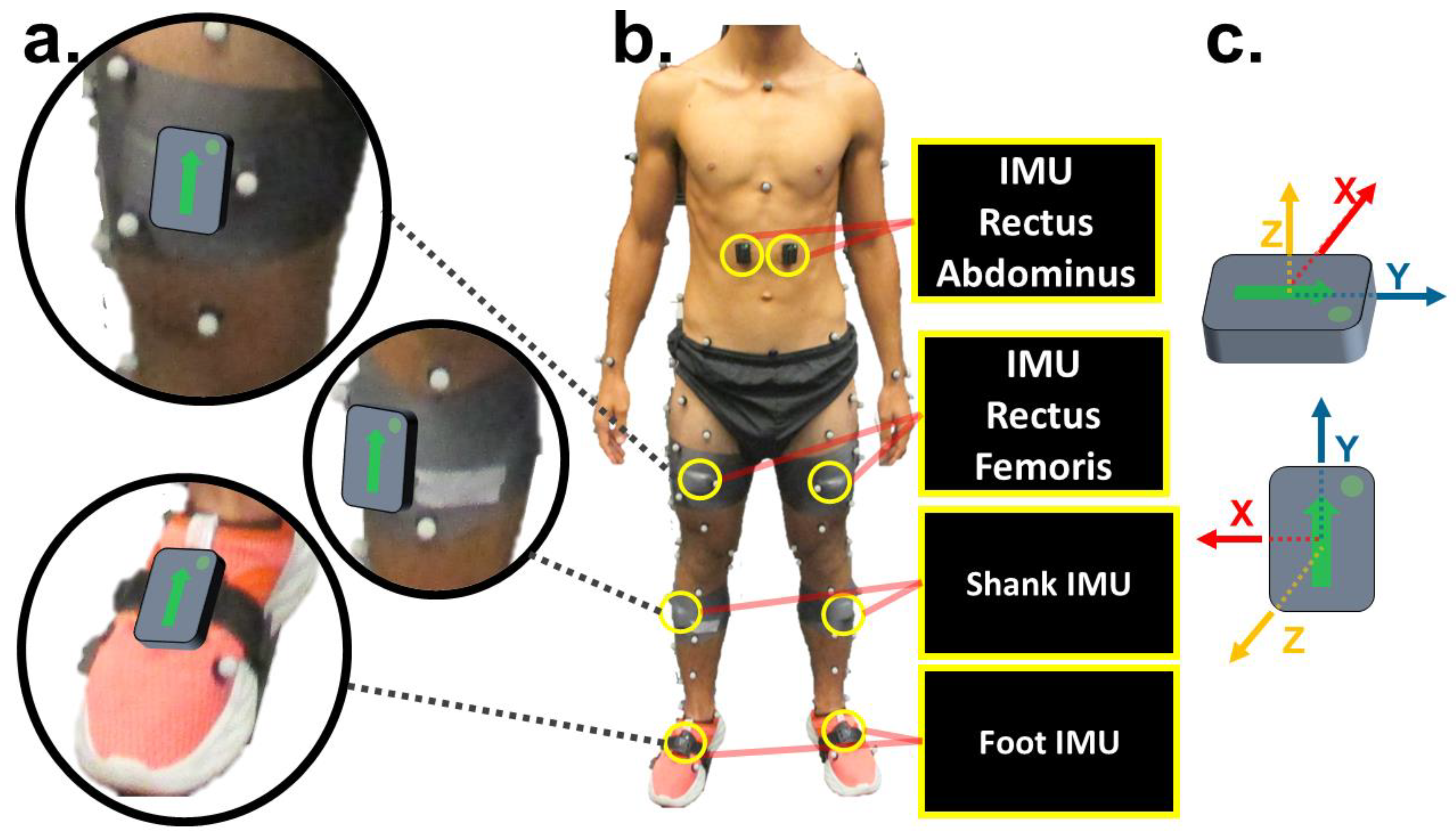
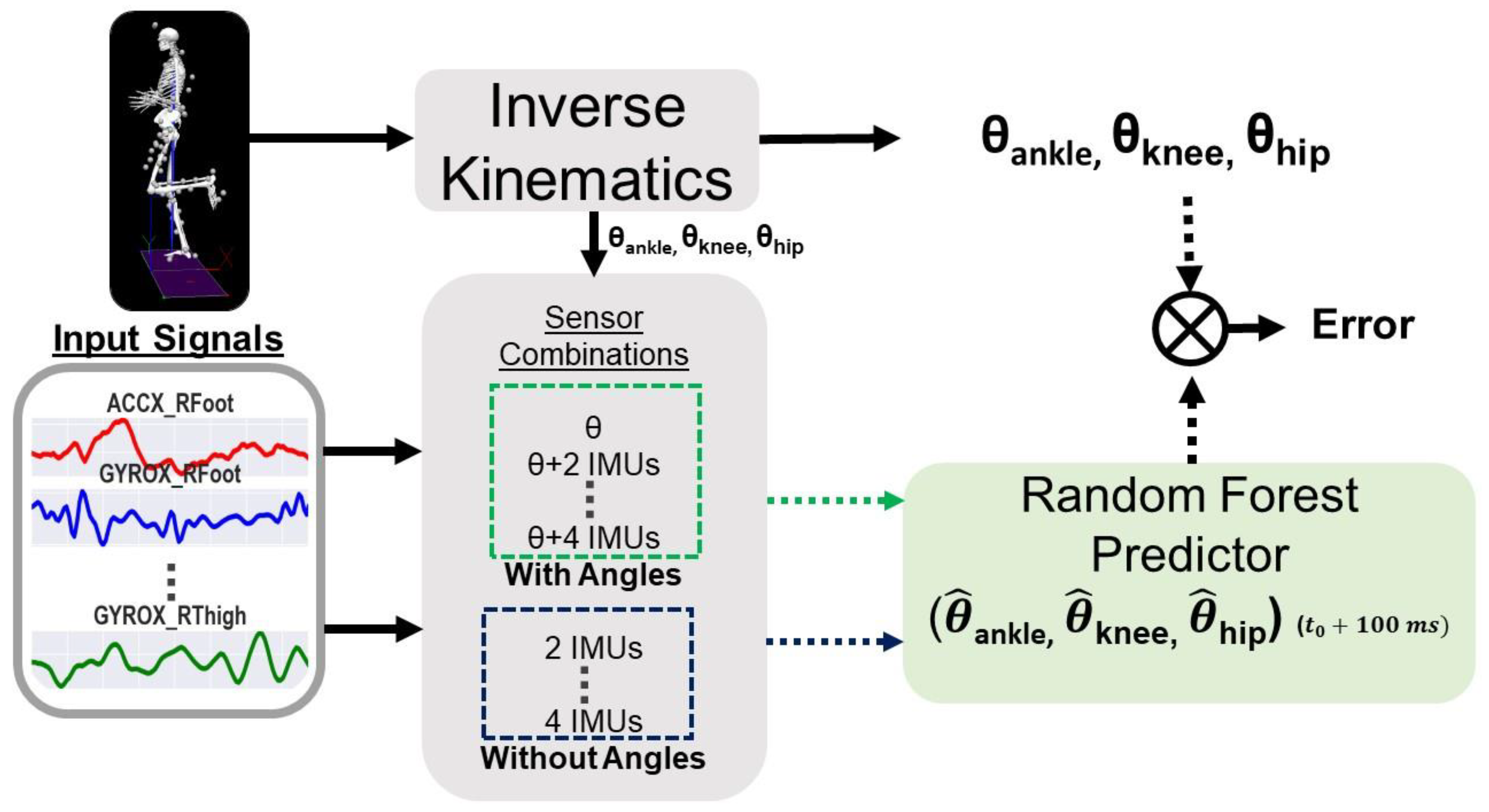
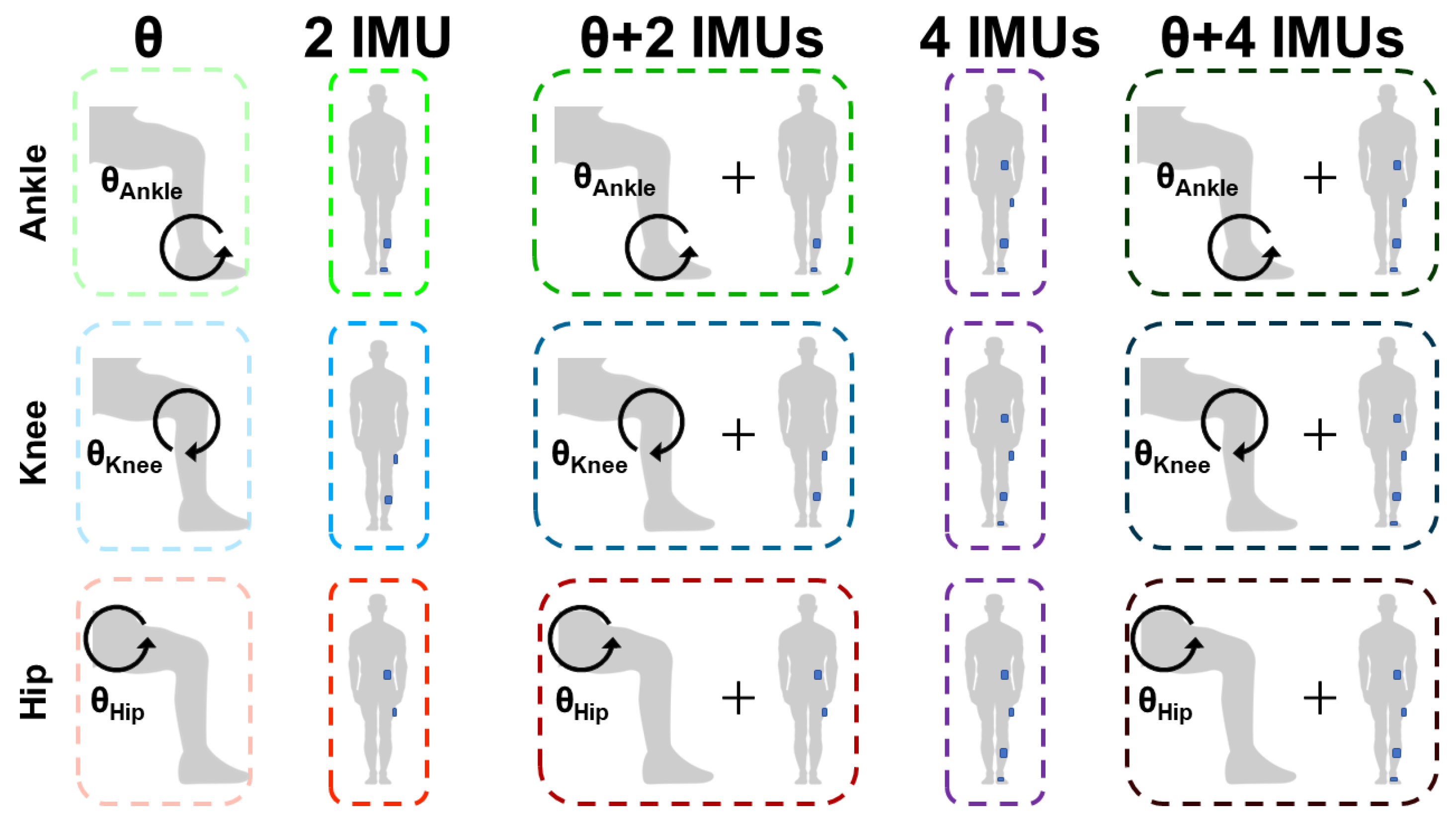
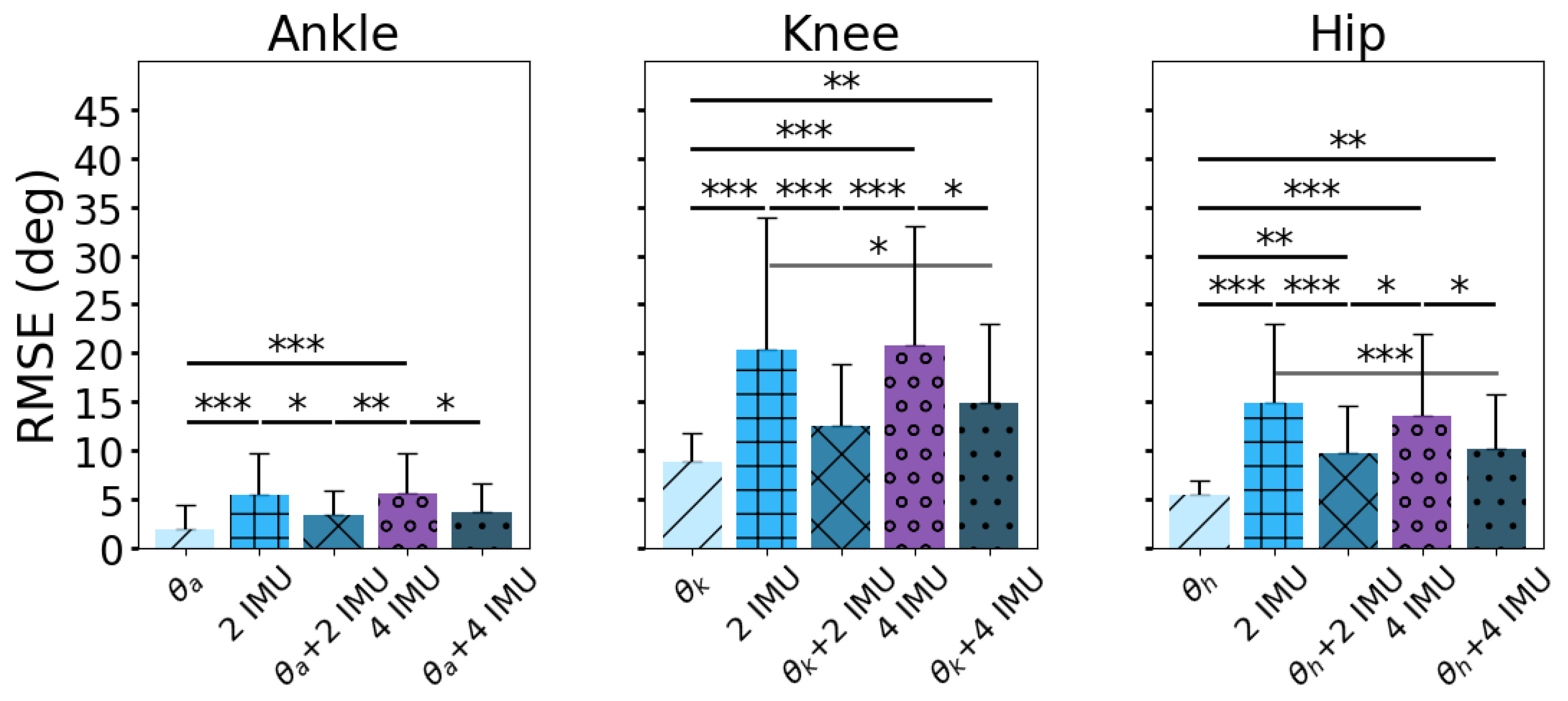
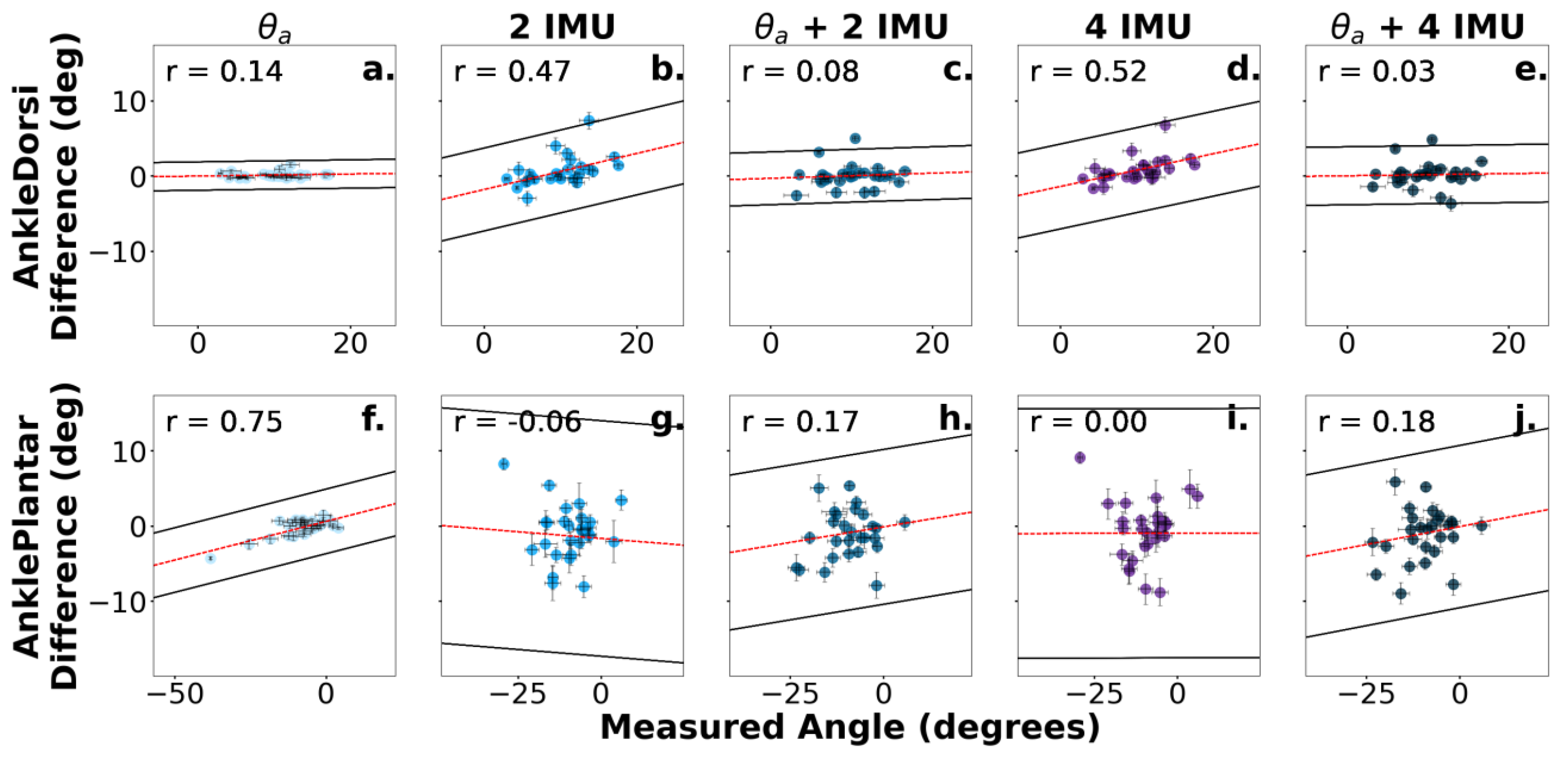

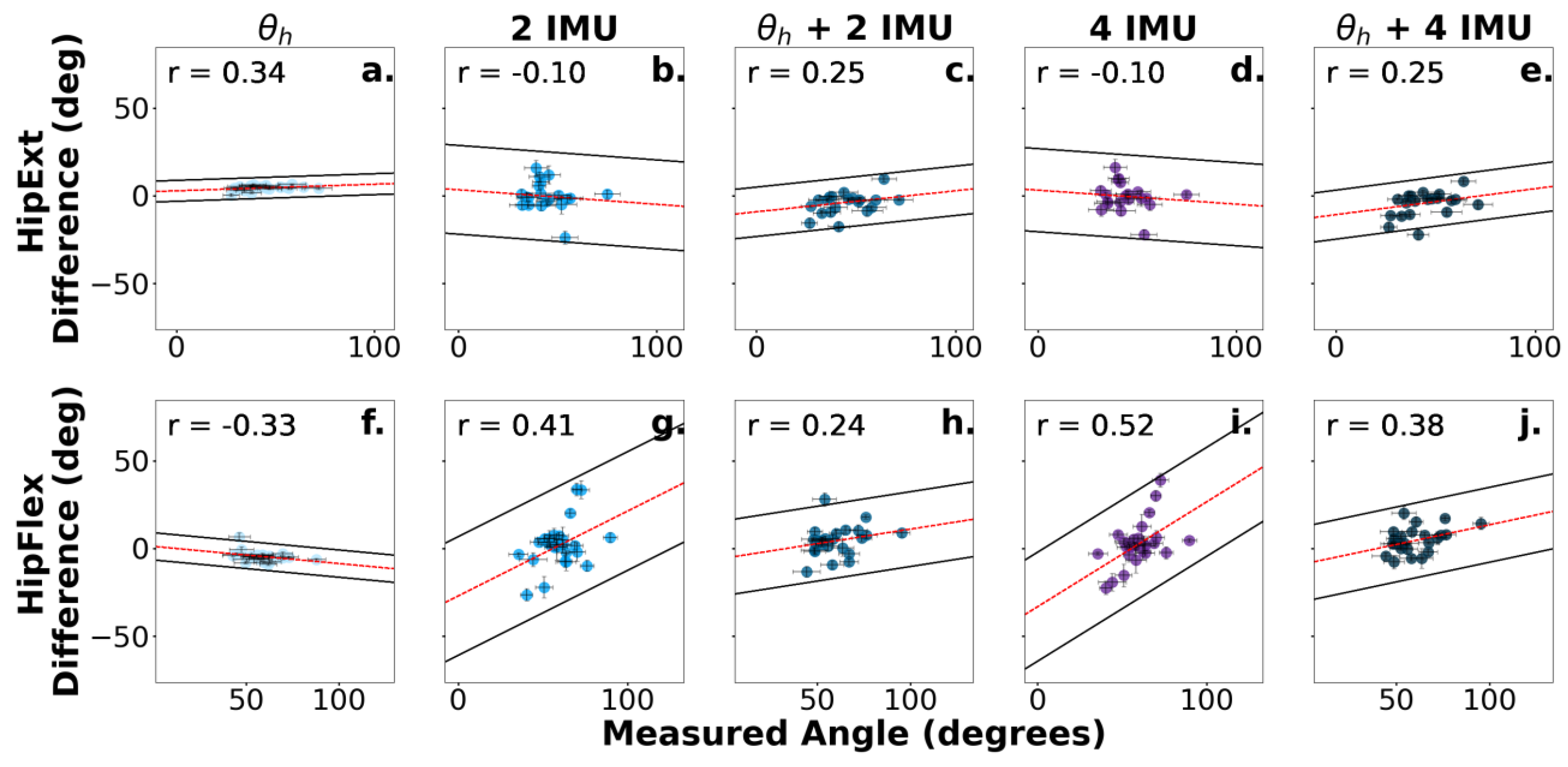
| Source | df | SS | MS | F | p |
|---|---|---|---|---|---|
| Ankle between groups | 4 | 3921.21 | 980.30 | ||
| Ankle within groups | 51 | 4069.78 | 79.79 | ||
| Ankle total | 279 | 7991.00 | None | 11.07 | <0.001 |
| Knee between groups | 4 | 57,979.06 | 14,494.76 | ||
| Knee within groups | 51 | 38,835.67 | 761.48 | ||
| Knee total | 279 | 96,814.73 | None | 15.69 | <0.001 |
| Hip between groups | 4 | 28,201.66 | 7050.41 | ||
| Hip within groups | 51 | 17,439.06 | 341.94 | ||
| Hip total | 279 | 45,640.7 | None | 18.92 | <0.001 |
| Group 1 | Group 2 | Mean Diff. | p-adj. | Lower | Upper | Cohen’s d |
|---|---|---|---|---|---|---|
| 2 IMU | 2 IMU + θa | −2.03 | <0.01 | −3.80 | −0.27 | −0.57 |
| 2 IMU | 4 IMU | 0.20 | 0.99 | −1.57 | 1.96 | 0.05 |
| 2 IMU | 4 IMU + θa | −1.69 | 0.070 | −3.46 | 0.070 | −0.46 |
| 2 IMU | θa | −3.43 | <0.001 | −5.20 | −1.67 | −0.98 |
| 2 IMU + θa | 4 IMU | 2.23 | <0.01 | 0.47 | 4.00 | 0.65 |
| 2 IMU + θa | 4 IMU + θa | 0.34 | 0.98 | −1.42 | 2.10 | 0.12 |
| 2 IMU + θa | θa | −1.40 | 0.19 | −3.16 | 0.36 | −0.55 |
| 4 IMU | 4 IMU + θa | −1.89 | 0.029 | −3.66 | −0.13 | −0.53 |
| 4 IMU | θa | −3.63 | <0.01 | −5.40 | −1.87 | −1.07 |
| 4 IMU + θa | θa | −1.74 | 0.055 | −3.50 | 0.024 | −0.64 |
| Group 1 | Group 2 | Mean Diff. | p-adj. | Lower | Upper | Cohen’s d |
|---|---|---|---|---|---|---|
| 2 IMU | 2 IMU + θk | −7.76 | <0.001 | −12.76 | −2.74 | −0.73 |
| 2 IMU | 4 IMU | 0.41 | 0.99 | −4.59 | 5.42 | 0.03 |
| 2 IMU | 4 IMU + θk | −5.48 | 0.023 | −10.49 | −0.47 | −0.49 |
| 2 IMU | θk | −11.51 | <0.001 | −16.52 | −6.50 | −1.16 |
| 2 IMU + θk | 4 IMU | 8.17 | <0.001 | 3.16 | 13.18 | 0.83 |
| 2 IMU + θk | 4 IMU + θk | 2.27 | 0.72 | −2.73 | 7.28 | 0.31 |
| 2 IMU + θk | θk | −3.75 | 0.24 | −8.76 | 1.25 | −0.77 |
| 4 IMU | 4 IMU + θk | −5.90 | 0.011 | −10.91 | −0.89 | −0.56 |
| 4 IMU | θk | −11.92 | <0.001 | −16.93 | −6.91 | −1.32 |
| 4 IMU + θk | θk | −6.02 | <0.01 | −11.03 | −1.01 | −0.98 |
| Group 1 | Group 2 | Mean Diff. | p-adj. | Lower | Upper | Cohen’s d |
|---|---|---|---|---|---|---|
| 2 IMU | 2 IMU + θh | −5.19 | <0.001 | −8.47 | −1.90 | −0.77 |
| 2 IMU | 4 IMU | −1.31 | 0.80 | −4.59 | 1.97 | −0.16 |
| 2 IMU | 4 IMU + θh | −4.79 | <0.001 | −8.07 | −1.50 | −0.68 |
| 2 IMU | θh | −9.38 | <0.001 | −12.66 | −6.09 | 1.60 |
| 2 IMU + θh | 4 IMU | 3.87 | 0.011 | 0.59 | 7.16 | 0.56 |
| 2 IMU + θh | 4 IMU + θh | 0.39 | 0.99 | −2.88 | 3.68 | 0.07 |
| 2 IMU + θh | θh | −4.19 | <0.01 | −7.47 | −0.90 | 1.15 |
| 4 IMU | 4 IMU + θh | −3.47 | 0.031 | −6.76 | −0.19 | −0.48 |
| 4 IMU | θh | −8.07 | <0.001 | −11.35 | −4.78 | 1.34 |
| 4 IMU + θh | θh | −4.59 | <0.01 | −7.87 | −1.30 | 1.10 |
Disclaimer/Publisher’s Note: The statements, opinions and data contained in all publications are solely those of the individual author(s) and contributor(s) and not of MDPI and/or the editor(s). MDPI and/or the editor(s) disclaim responsibility for any injury to people or property resulting from any ideas, methods, instructions or products referred to in the content. |
© 2024 by the authors. Licensee MDPI, Basel, Switzerland. This article is an open access article distributed under the terms and conditions of the Creative Commons Attribution (CC BY) license (https://creativecommons.org/licenses/by/4.0/).
Share and Cite
Hollinger, D.; Schall, M.C., Jr.; Chen, H.; Zabala, M. The Effect of Sensor Feature Inputs on Joint Angle Prediction across Simple Movements. Sensors 2024, 24, 3657. https://doi.org/10.3390/s24113657
Hollinger D, Schall MC Jr., Chen H, Zabala M. The Effect of Sensor Feature Inputs on Joint Angle Prediction across Simple Movements. Sensors. 2024; 24(11):3657. https://doi.org/10.3390/s24113657
Chicago/Turabian StyleHollinger, David, Mark C. Schall, Jr., Howard Chen, and Michael Zabala. 2024. "The Effect of Sensor Feature Inputs on Joint Angle Prediction across Simple Movements" Sensors 24, no. 11: 3657. https://doi.org/10.3390/s24113657
APA StyleHollinger, D., Schall, M. C., Jr., Chen, H., & Zabala, M. (2024). The Effect of Sensor Feature Inputs on Joint Angle Prediction across Simple Movements. Sensors, 24(11), 3657. https://doi.org/10.3390/s24113657





